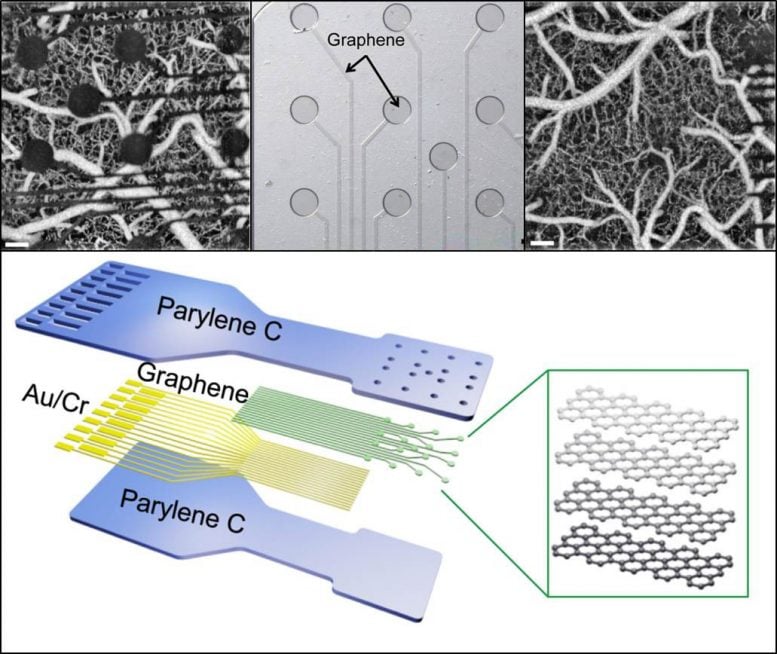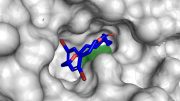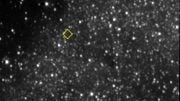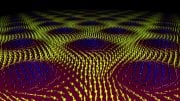
Conventional metal electrode technologies (top left) are opaque, obstructing views of underlying neural tissue. DARPA’s RE-NET program has developed new graphene sensors that are electrically conductive but only 4 atoms thick—hundreds of times thinner than current contacts (top middle). Their extreme thinness enables nearly all light to pass through across a wide range of wavelengths. Placed on a flexible plastic backing that conforms to the shape of tissue (bottom), the sensors are part of a proof-of-concept tool that demonstrates much smaller, transparent contacts that can measure and stimulate neural tissue using electrical and optical methods at the same time (top right). Credit: DARPA
New nanotechnology funded by DARPA’s RE-NET program and developed by researchers at the University of Wisconsin at Madison enables monitoring and stimulation of neurons using optical and electronic methods simultaneously.
Understanding the anatomical structure and function of the brain is a longstanding goal in neuroscience and a top priority of President Obama’s brain initiative. Electrical monitoring and stimulation of neuronal signaling is a mainstay technique for studying brain function, while emerging optical techniques—which use photons instead of electrons—are opening new opportunities for visualizing neural network structure and exploring brain functions. Electrical and optical techniques offer distinct and complementary advantages that, if used together, could offer profound benefits for studying the brain at high resolution. Combining these technologies is challenging, however, because conventional metal electrode technologies are too thick (>500 nm) to be transparent to light, making them incompatible with many optical approaches.
To help overcome these challenges, DARPA has created a proof-of-concept tool that demonstrates much smaller, transparent contacts that can measure and stimulate neural tissue using electrical and optical methods at the same time. Researchers at the University of Wisconsin at Madison developed the new technology with support from DARPA’s Reliable Neural-Interface Technology (RE-NET). It is described in detail in a paper in Nature Communications.
“This technology demonstrates potentially breakthrough capabilities for visualizing and quantifying neural network activity in the brain,” said Doug Weber, DARPA program manager. “The ability to simultaneously measure electrical activity on a large and fast scale with direct visualization and modulation of neuronal network anatomy could provide unprecedented insight into relationships between brain structure and function—and importantly, how these relationships evolve over time or are perturbed by injury or disease.”
The new device uses graphene, a recently discovered form of carbon, on a flexible plastic backing that conforms to the shape of tissue. The graphene sensors are electrically conductive but only 4 atoms thick—less than 1 nanometer and hundreds of times thinner than current contacts. Its extreme thinness enables nearly all light to pass through across a wide range of wavelengths. Moreover, graphene is nontoxic to biological systems, an improvement over previous research into transparent electrical contacts that are much thicker, rigid, difficult to manufacture, and reliant on potentially toxic metal alloys.
The technology demonstration draws upon three cutting-edge research fields: graphene, which earned researchers the 2010 Nobel Prize in Physics; super-resolved fluorescent microscopy, which earned researchers the 2014 Nobel Prize in Chemistry; and optogenetics, which involves genetically modifying cells to create specific light-reactive proteins.
RE-NET seeks to develop new tools and technologies to understand and overcome the failure mechanisms of neural interfaces. DARPA is interested in advancing next-generation neurotechnologies for revealing the relationship between neural network structure and function. RE-NET, and subsequent DARPA programs in this field, plan to leverage this new tool by simultaneously measuring the function, physical motion, and behavior of neurons in freely moving subjects. This technology provides the capability to modulate neural function, by applying programmed pulses of electricity or light to temporarily activate neurons. Therefore, it could not only provide better observation of native functionality but also, through careful modulation of circuit activity, enable exploration of causal relationships between neural signals and brain function.
“Historically, researchers have been limited to correlational studies that suggest, but do not prove causal linkages between neural activity and behavior,” Weber said. “Now, we have the opportunity to directly see, measure and stimulate neural circuits to explore these relationships and develop and validate models of brain circuit function. This knowledge could greatly aid how we understand and treat brain injury and disease.”
RE-NET is part of a broader portfolio of programs within DARPA that support President Obama’s brain initiative. These programs include ongoing efforts designed to advance fundamental understanding of the brain’s dynamics to drive applications (Revolutionizing Prosthetics, Restorative Encoding Memory Integration Neural Device, Reorganization and Plasticity to Accelerate Injury Recovery, Enabling Stress Resistance), manufacture sensing systems for neuroscience applications and therapies (Hand Proprioception & Touch Interfaces, Electrical Prescriptions) and analyze large data sets (Detection and Computational Analysis of Psychological Signals).
Reference: “Graphene-based carbon-layered electrode array technology for neural imaging and optogenetic applications” by Dong-Wook Park, Amelia A. Schendel, Solomon Mikael, Sarah K. Brodnick, Thomas J. Richner, Jared P. Ness, Mohammed R. Hayat, Farid Atry, Seth T. Frye, Ramin Pashaie, Sanitta Thongpang, Zhenqiang Ma and Justin C. Williams, 20 October 2014, Nature Communications.
DOI: 10.1038/ncomms6258








Be the first to comment on "New Graphene Sensors Could Provide Unprecedented Insights into Brain Structure"